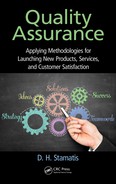287Supplier’s Perspective on the PPAP
• Alerts: An interim PSW always needs an alert and vice versa. A
copyof the alert must be attached to the PSW. The alert num-
bermust be entered in the “Additional Engineering Changes”
box and a brief one-line description in the “Explanation/
Comments” box. For capacity issues, write the actual versus the
daily production volume (DPV) needed (taken from the request
for quote [RFQ]).
• Submission results: An interim PSW alwaysmeans the “No” box
is ticked by the supplier on the PSW. The “Yes” box should be
ticked for capacity reasons only because all specications are met.
• Format: An interim PSW must have the word INTERIM in the
top right-hand corner of the PSW, followed in brackets by either
CAPACITY for capacity-related deciencies or TECHNICAL/
QUALITY for all other nonconformancies, for example, dimen-
sional, process, test, and so on.
• Elect: Program buyers should enter only interim (capacity)
PSWs into elect as “INTERIM.” Interim (technical/quality) PSWs
should not be entered into elect. Interim (technical/quality) PSWs
have to be followed up by the authorized customer representa-
tive until full PSW approval.
• Rejected PSW: This indicates that the supplier is not allowed to
submit parts/materials to the customer because the parts/mate-
rials do not meet specications and an alert is not available.
Mandatory: For some customers, attach OEE and capacity docu-
mentation to rejected PSW submission. Typical options with a
rejected PSW are
• For PPAP level 2–5, the authorized customer representative ticks
the “Rejected” box and writes “Reject” on the top right-hand cor-
ner of PSW to make it clear to others it is not an Interim Approved
or Full PSW.
• Any PSW with a nonconformity that is not covered by an alert is
rejected, that is, no parts can be shipped.
References
AIAG. (2008). Advanced Product Quality Planning and Control Plan, 2nd ed. Southeld,
MI: Automotive Industry Action Group, Chrysler Corporation, Ford Motor
Company, General Motors.
AIAG. (2009). Production Part Approval Process (PPAP), 4th ed. Southeld, MI:
Automotive Industry Action Group, Chrysler Corporation, Ford Motor
Company, General Motors.
288 Quality Assurance
Stamatis, D. (2004). Integrating ISO 9001 with ISO/TS 16949 and AS 9000. Milwaukee,
WI: Quality Press.
Stamatis, D. (2010). The OEE Primer: Understanding Overall Equipment Effectiveness,
Reliability and Maintainability. Boca Raton, FL: CRC Press.
Selected Bibliography
DaimlerChrysler. (2010). DaimlerChrysler Customer-Specic Requirements for Use with
ISO/TS 16949. http://www.ask.com/web?qsrc=1&o=11517&l=dir&q=Dai
mlerChrysler+specic+requirements&qo=serpSearchTopBox. Retrieved on
September 29, 2014.
Ford Motor Company. (2010). Ford Motor Company Customer-Specic Requirements For
use with PPAP, 4th ed. Dearborn, MI: Ford. http://www.iatfglobaloversight.
org/docs/Ford_Specics_for_PPAPJune2013.pdf. Retrieved on September 29,
2014.
GM. (2010). GM Customer Specics—ISO/TS 16949: Including GM Specic Instructions for
PPAP, 4th ed. GM. http://www.iatfglobaloversight.org/docs/Minimum%20
Automotive%20Quality%20Management%20System%20Requirements%20
for%20Sub-tier%20suppliers%20-%20AUG%2014.pdf. Retrieved on September
29, 2014.
..................Content has been hidden....................
You can't read the all page of ebook, please click here login for view all page.
